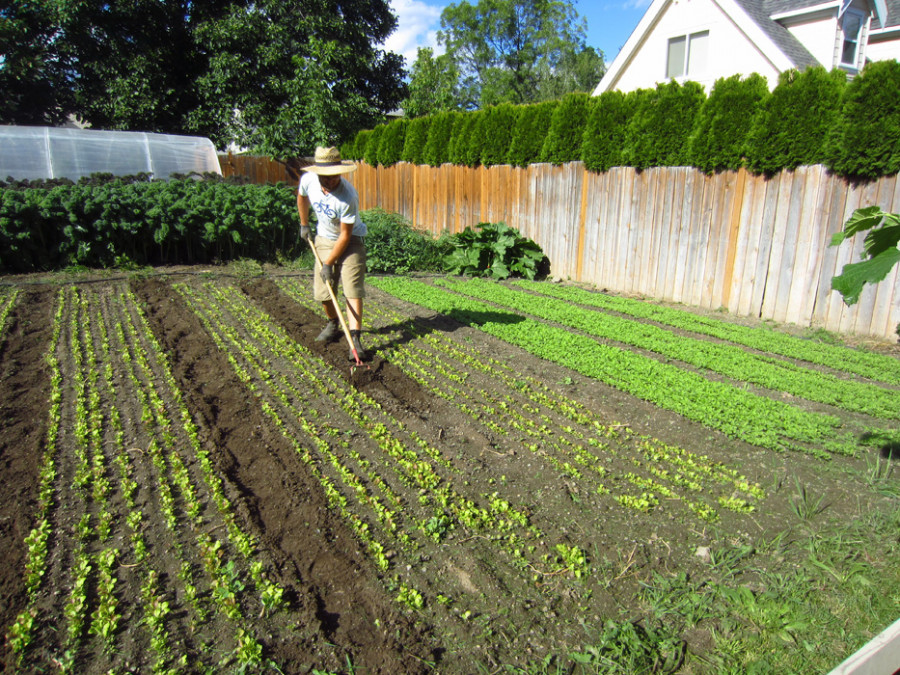No Field, No Problem
Urban Agriculture Movement Gaining Ground at ConU
You don’t need a field to build a farm.
The urban agriculture movement, once considered radical, has been steadily gaining momentum, perhaps for the simple fact that the principles at its core are almost universally agreed upon.
“[Urban agriculture] involves every day of our lives. We eat food every single day,” said Marcus Lobb, a coordinator at the Concordia greenhouse.
“Anyone who’s ever grown and eaten their own food automatically goes, ‘Oh my God, this tastes so much better.’”
Curtis Stone, a sustainable farmer from British Columbia, agrees.
“I discovered it’s [an easy sell],” he said. “It’s not like I’m selling some consumer crap that somebody doesn’t need. This is good, wholesome food that everybody needs.”
Proponents of urban agriculture propose a local, organic and sustainable model that would encourage continued and ready access to healthy, affordable food for generations to come.
According to Samuel Oslund, who runs Santropol Roulant’s urban farm, “It’s creating more access for people who typically may not have access to healthy food. It’s great to be able to help make it more equitable.”
Urban Agriculture Movement Reaches Concordia
The momentum in the urban agriculture movement is reflected in the rapid growth of participation in activities at the Concordia greenhouse over the last three years.
“We’ve been trying to encourage education as a component of the greenhouse,” said Lobb. Having established a series of workshops, film screenings and a resource library related to farming and ecological issues, the greenhouse organization applied for a strategic fund with the intention of hosting an intensive five-day urban agriculture school.
The result was the City Farm School. After a highly successful first run in 2011, the school has grown in 2012 to span the entire growing season and has begun selling its harvest.
Funds for specialized projects and opportunities for internships and volunteering have also grown steadily.
The City Farm School announced last December the creation of three internship programs for students interested in new approaches to farming.
Among them is a special medicinal plants internship that will be launched with a panel discussion and workshop on Feb. 7 and that will introduce participants to an innovative new mode of farming called SPIN farming.
SPIN, which stands for small plot intensive, is a technique first developed by Wally Satzewich, a Saskatoon urban farmer. It diverges from conventional commercial farming by making smart use of sub-acre plots of land, generally available in urban and peri-urban areas.
“There is so much land in the city. Some people don’t care about their lawns, some are elderly and it’s actually a hassle for them to [maintain],” said Lobb.
In Stone’s case, very good use was made of an otherwise abandoned site.
“The main farm site I developed in the first place was totally derelict. I found 300 needles there,” said Stone of the site, which had been frequented by drug users. “From something that didn’t do anything for the community, I took it to somewhere that feeds the community and is an economic engine.”
Smaller plots of land mean less infrastructure is required and initial capital investment is minimal.
“Our whole operation is done by [bicycle-powered machines] and just two people,” said Stone. “Our deliveries are done by bike.”
Proximity to urban centres also reduces the costs of transport, both environmentally and monetarily.
“You can be suburban and you’re still close enough to [your consumers],” said Stone. “I have friends, commercial urban farmers, in San Francisco, who take their produce and their market stuff on the metro.”
A SPIN farming workshop will take place on Feb. 9 and will be hosted by Stone, who used SPIN farming principles to set up his farm, Green City Acres, in Kelowna, BC.
“[There will be] enough info to give people a kick in the ass, to say, ‘Okay, I think I can do this.’ I give an honest look at what’s involved in running a farm. I try not to romanticize too much,” said Stone. “Although it’s hard not to romanticize, because it’s a pretty great lifestyle.”

Sustainable Food Can Be Sustainable Business
Helping make that lifestyle so great is the profit that can come of it.
Whereas much of urban farming so far has been very ideological and hobbyist, SPIN provides a methodology to make urban agriculture a highly profitable, entrepreneurial venture.
According to the official SPIN farming website, once properly set up, young farmers can expect to produce $50,000 worth of vegetables for half an acre of land and according to Stone, this figure is conservative.
The model emphasizes crops with high turnover and value by weight to make the farm profitable.
“It’s about being smarter, using land wisely, versus just using more technology, more inputs and having more land,” said Oslund. “You’re sometimes talking half an acre of production, so it’s geared towards stuff that turns over fast: greens, sprouts. Things that take up little room and have a high per-pound value.”
Stone produces 30,000 lbs of vegetables on three-quarters of an acre. He grows mainly spring mix, microgreens, radishes, baby turnips, and baby beets—all crops that grow within a 60-day cycle.
If the model gains in popularity, it promises to redefine what it means to be a farmer.
“The old agricultural paradigm is dying,” Stone said. “Our American culture totally diminishes the value of farmers—it’s not something that people [think about getting into].”
But their loss is Stone’s gain.
“I actually get a really nice livable income from being a farmer, which is unheard of,” he said. “Over the last 50 years, farmers have typically been burdened with copious amounts of debt.”
The best part is that anyone can do it.
“I went from not knowing anything [about gardening], aside from some experience in tree planting, to being a commercial farmer in [about a] year,” recounts Stone.
“I spent the winter of [2009] just reading these books, started developing one farm site in August 2009 and got the farm ready to plant about February. I was selling vegetables by April 2010.
“I think it’s encouraging a lot of people into the idea that you can actually farm and make a living and provide for yourself.”
Stone likened the current situation in urban agriculture to the dot-com boom of the 1990s—people who get on board now find a wide open market and cheap resources.
“There are all these opportunities for young farmers,” Stone said. “There is available land, not to buy but just to use, for free, tons of it everywhere, because there are no farmers.
“It’s the time to set yourself up as a farmer. There are tons of opportunities, infrastructure’s cheap, greenhouses, seeds are still cheap,” he continued.
“I started my farm on $7,000 and you can do that. Setting up now is going to be a huge advantage compared to setting up in ten years.”
Update: The original version of this article said the medicinal plants internship launch was Feb. 9. In reality, it is Feb. 7. The story has been updated to reflect that. The Link regrets the error.


_600_832_s.png)

WEB_600_375_90_s_c1.jpg)

